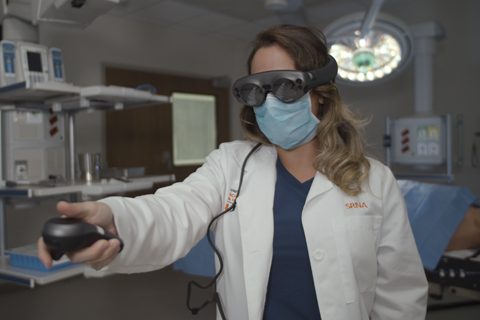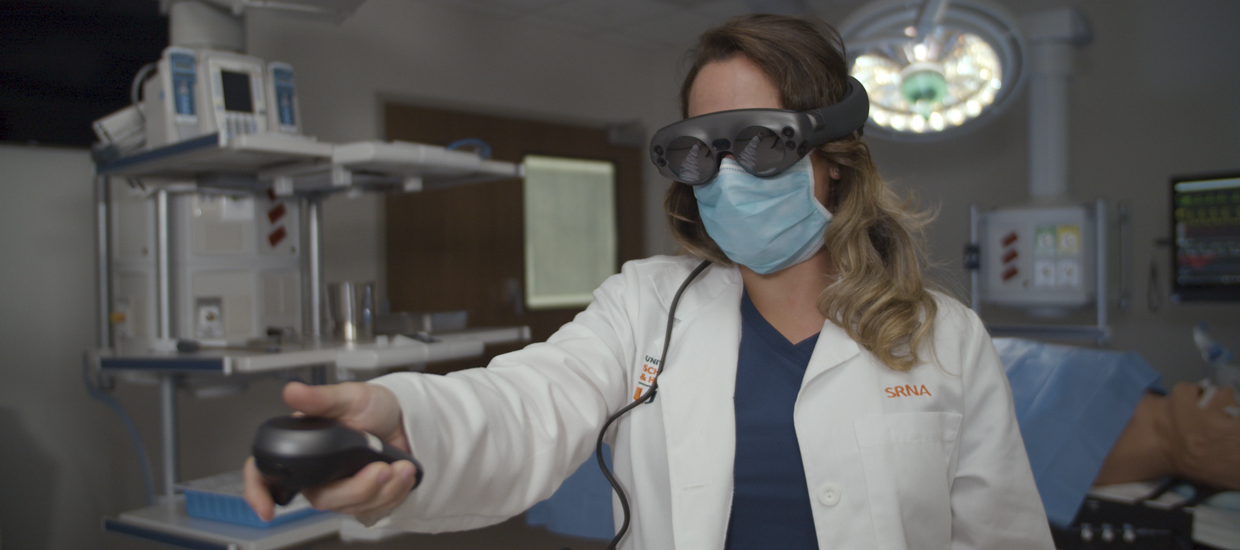From forced-air warming blankets to bispectral index monitors, no matter how much you’ve learned about equipment, setup, procedures, and monitoring, your introduction to an operating room (OR) can be a confusing, even frightening experience.
“When I first walked into the OR it was very intimidating,” recalls third-year nurse anesthesia student Kelsey Boily. “I felt very lost and I didn’t really know how to set up the equipment.”
Even with the best preparation, a student’s first clinical day can be their first time seeing a fully equipped OR in person. But a new mixed-reality simulation conceived and co-developed by faculty and students at the School of Nursing and Health Studies has changed that.
Now, well before they step foot into the OR for clinicals, first-year Student Registered Nurse Anesthetists (SRNAs) at SONHS can put on Magic Leap goggles and step into a virtual anesthesia suite to practice a series of patient preparation activities with a wide range of anesthesia equipment that would be too expensive to purchase and maintain for real-world physical simulations.
“We keep telling the students about all these things they’ll encounter in the OR, but they have no idea what the equipment looks like and how it operates until they go into the operating room for the first time,” explains Greta Mitzova-Vladinov, the SONHS faculty member who led development of the app. “This app allows them to become familiar with all of the equipment and supplies they’ve never seen before.”
The project, Escape Operating Room, was selected for funding from the office of Jeffrey Duerk, executive vice president for academic affairs and provost, through a competitive proposal process for UM’s XR Initiative. Escape OR uses Magic Leap goggles to transport first-year SRNAs from whatever physical space they’re using into a virtual OR. The training was named Escape OR, says Mitzova-Vladinov, because students must maneuver successfully through three modules, manipulating the virtual equipment as they go.
Much like in a video game, students navigate the immersive space while using a handheld remote to set up equipment and interact with the patient. By doing this, they how and why equipment is used, as well as where the patient’s physiologic values are displayed on the anesthesia monitor.
The first module covers use of normothermia equipment, such as the Bair Hugger forced-air warming blanket, which is used to regulate the patient’s body temperature under anesthesia. In the next module, students learn to set up fluid warming equipment frequently used to deliver large intravenous fluid boluses for fluid management in anesthetized surgical patients. They learn fluid administration in this interactive environment by understanding its effect on pulse pressure variation and other physiologic parameters. The third and final module features equipment for monitoring depth of anesthesia. Students use the remote device to practice filling liquid anesthetic cassettes properly and placing a bispectral index monitor on the patient to gauge sedation level.
“Some of the biggest problems novice learners and junior students have when they’re first entering the clinical arena is their lack of confidence and high anxiety levels in the unfamiliar operating room environment,” says Mitzova-Vladinov, associate director of the nurse anesthesia program and assistant professor of clinical.
But with the Magic Leap goggles and Escape OR app, students can practice anywhere they have a bit of empty space, enhancing their in-person teaching and simulation activities.
“This provides the students an opportunity to really see the equipment and learn how to set it, so when they walk into the OR they can feel much more confident,” says SRNA Boily, who, along with classmate Jackie Ferreira, helped Mitzova-Vladinov develop the app. For her D.N.P. scholarly project, Boily plans to create another mixed-reality app, this time to assist with difficult airway training.
Building an OR App
Escape OR’s genesis came when Mitzova-Vladinov asked then-second-year students Boily and Ferreira how they would go about familiarizing first-year nurse anesthesia students who have not yet been in the clinical environment with the equipment, terminology, and everything else they would encounter in an OR.
Boily and Ferreira suggested producing and narrating a series of videos demonstrating set up and use of the equipment in a real operating room, with quizzes along the way. The SONHS team then shared the completed videos with their XR Initiative collaborators Michael Mannino, project lead from UM’s Institute for Data Science & Computing, and Nicolas Alberti, of UM’s Center for Computational Science, who worked on Escape OR’s design and development with Xennial Digital Studios.
After Beta testing and practice sessions, Mitzova-Vladinov implemented Escape OR with her first-year students in Summer 2020. Based on survey results, she found all users highly satisfied with the application. “They can wear the goggles, practice as many times as they want, and feel more confident when they enter the clinical setting,” she adds. “The whole runthrough takes around 15 minutes.”
Mixed-Reality Curriculum
Escape OR is the fourth mixed-reality simulation SONHS faculty have created using Magic Leap goggles. The project is part of the University’s XR Initiative to use augmented, virtual, and mixed reality in learning and research, founded on the belief that immersive environments will be an important platform for a variety of fields, including education and health care.
Mitzova-Vladinov now sits on UM’s XR Initiative Advisory Board and continues her commitment to advance nurse anesthesia education with the use of emerging technologies such as virtual and mixed-reality simulations. She is evaluating Escape OR and expects its innovative approach to have lasting benefits, especially in the wake of COVID-19.
“My bottom line is getting the students to understand this anesthesia equipment,” she says. “Now they can practice individually in any empty space and figure out how and why everything works together, so they are more prepared to enter the complex clinical environment.”
Go to https://xr.miami.edu/projects to find a demo video of Escape OR.





